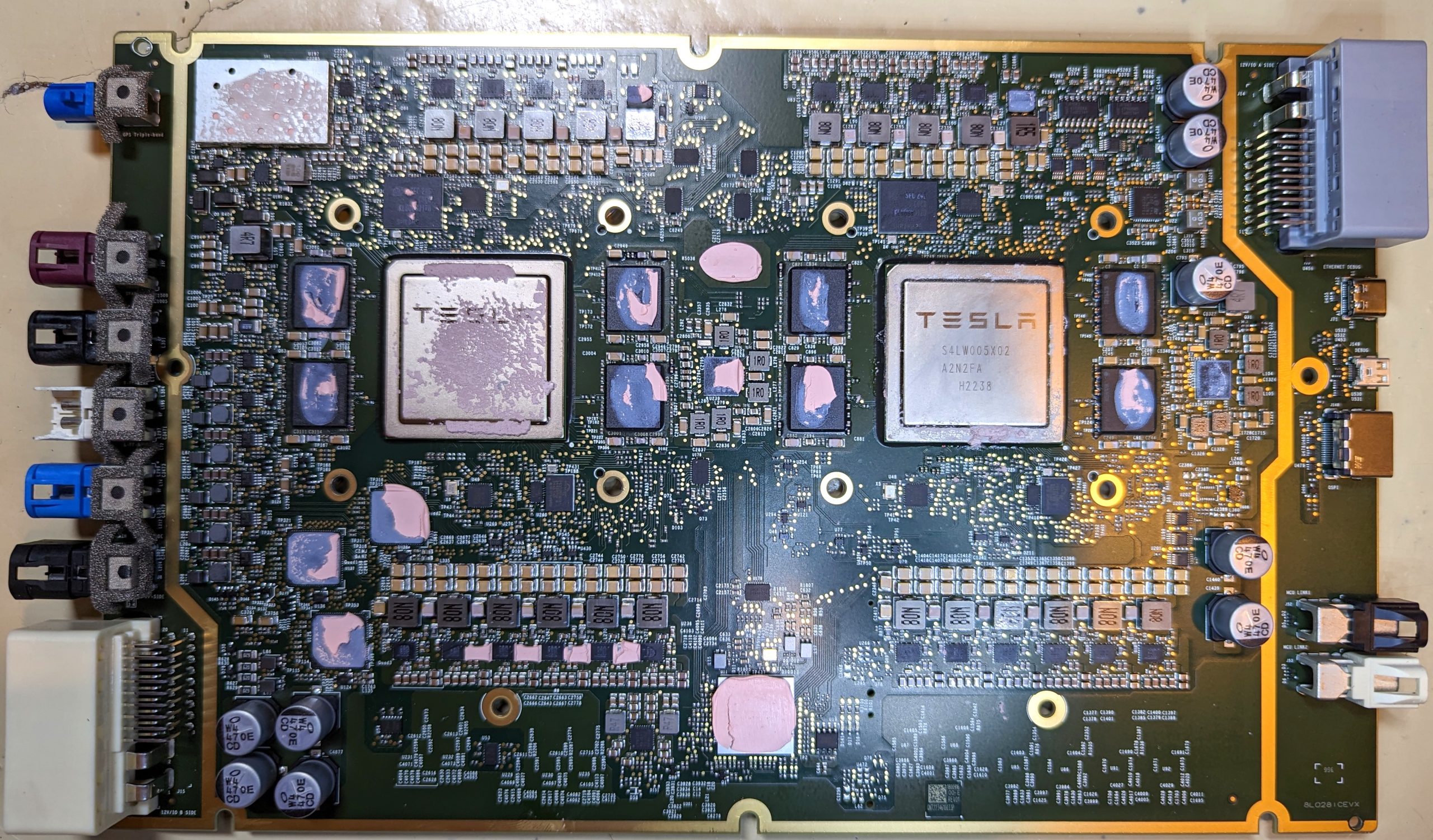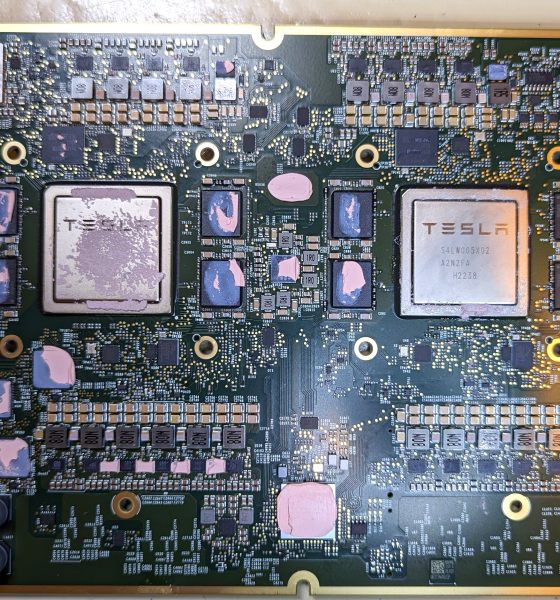New images and details surrounding Tesla’s most robust self-driving computer, or Hardware 4 (HW4), were shown today, revealing additional cameras, a reintroduction of potential radar systems, and more.
Tesla released some details about HW4 during last year’s AI Day event. Still, additional specifications were revealed today by Greentheonly, a Tesla hacker who said the computer came from a Model X vehicle. Green said that Tesla has already started building vehicles with the new computer, but they are not yet being delivered.
I am sure you are all eager to know more about HW4, so I am going to show you the refreshed car computer from a Model X. Just don’t tell anybody you saw it, because it’s really a secret still.
This unit made appearance at the EPC about a month ago, but the picture was hidden. pic.twitter.com/7AENqP6h2Z— green (@greentheonly) February 15, 2023
Right off the bat, green confirms what CEO Elon Musk said during the most recent earnings call: retrofits of HW4 into older vehicles will not be possible. While green shows the form factor of the new computer is completely different than past ones, even the most recent applications that were installed in Plaid vehicles, the new HW4 is simply not compatible.
Musk said during the Q4 Earnings Call in late January:
“But it is the cost and difficulty of retrofitting Hardware 3 with Hardware 4 is quite significant. So it would not be, I think, economically feasible to do so.”
Many of the specifics of HW4 are extremely technical, but it appears Tesla aimed to simplify the infotainment system to void a GPU daughterboard. The entire unit is smaller and sleeker, but the RAM, NVMe (nonvolatile memory express), CPU, and GPU are all identical to past units.
Green adds:
“A lot less improvement than many hoped for. Still Samsung Exynos-IP based. Bumped CPU cores from 12 to 20 (5 clusters of 4 cores each), maxing at 2.35GHz, idle at 1.37GHz Number of TRIP cores increased from 2 to 3, 2.2GHz max freq All x2 since there are two SoCs per board.”
HW4:
A lot less improvement than many hoped for.
Still Samsung Exynos-IP based.
Bumped CPU cores from 12 to 20 (5 clusters of 4 cores each), maxing at 2.35GHz, idle at 1.37GHz
Number of TRIP cores increased from 2 to 3, 2.2GHz max freq
All x2 since there are two SoCs per board pic.twitter.com/eeHXg5x0aL— green (@greentheonly) February 15, 2023
Perhaps one of the most notable differences are there are now 12 “fully-populated camera connectors,” with one being utilized as a spare. The cameras are also labeled, and some seem to indicate that cameras will be added to the front and rear bumpers. “There’s a huge blindspot up front on legacy cars up front,” green notes.
What’s SVC you might wonder? According to EPC, SVC is bumper. So I’d guess these are bumper cameras. There’s a huge blindspot upfront on legacy cars up front (welcome to the legacy camp, Plaid owners!), so front bumper camera and two in the (rear?) bumper corners for x-traffic pic.twitter.com/sixzNo7qII
— green (@greentheonly) February 15, 2023
This would make sense, considering Teslas currently utilize eight cameras, with the additional three connectors making way for the two rear and one front camera that will be added with the new hardware.
Another interesting detail found by green was Phoenix radar, which is a rumored 4-dimensional radar that will help extend current reach by double. Tesla wanted to move away from radar, opting for a completely camera-based approach, which it did with the introduction of its Vision model.
Musk said during the Q1 2021 Earnings Call:
“When your vision works, it works better than the best human because it’s like having eight cameras, it’s like having eyes in the back of your head, beside your head, and has three eyes of different focal distances looking forward. This is — and processing it at a speed that is superhuman. There’s no question in my mind that with a pure vision solution, we can make a car that is dramatically safer than the average person.”
However, radar and a radar heater were both seen in vehicle coding. The Phoenix radar appears to be a type of forward radar that will be installed in HW4 vehicles.
Perhaps more details will be shed regarding HW4 in the coming weeks, especially as Tesla’s Investor Day is approaching and will take place on March 1.
I’d love to hear from you! If you have any comments, concerns, or questions, please email me at joey@teslarati.com. You can also reach me on Twitter @KlenderJoey, or if you have news tips, you can email us at tips@teslarati.com.

Elon Musk
SpaceX issues statement on Starship V3 Booster 18 anomaly
The incident unfolded during gas-system pressure testing at the company’s Massey facility in Starbase, Texas.

SpaceX has issued an initial statement about Starship Booster 18’s anomaly early Friday. The incident unfolded during gas-system pressure testing at the company’s Massey facility in Starbase, Texas.
SpaceX’s initial comment
As per SpaceX in a post on its official account on social media platform X, Booster 18 was undergoing gas system pressure tests when the anomaly happened. Despite the nature of the incident, the company emphasized that no propellant was loaded, no engines were installed, and personnel were kept at a safe distance from the booster, resulting in zero injuries.
“Booster 18 suffered an anomaly during gas system pressure testing that we were conducting in advance of structural proof testing. No propellant was on the vehicle, and engines were not yet installed. The teams need time to investigate before we are confident of the cause. No one was injured as we maintain a safe distance for personnel during this type of testing. The site remains clear and we are working plans to safely reenter the site,” SpaceX wrote in its post on X.
Incident and aftermath
Livestream footage from LabPadre showed Booster 18’s lower half crumpling around the liquid oxygen tank area at approximately 4:04 a.m. CT. Subsequent images posted by on-site observers revealed extensive deformation across the booster’s lower structure. Needless to say, spaceflight observers have noted that Booster 18 would likely be a complete loss due to its anomaly.
Booster 18 had rolled out only a day earlier and was one of the first vehicles in the Starship V3 program. The V3 series incorporates structural reinforcements and reliability upgrades intended to prepare Starship for rapid-reuse testing and eventual tower-catch operations. Elon Musk has been optimistic about Starship V3, previously noting on X that the spacecraft might be able to complete initial missions to Mars.
Investor's Corner
Tesla analyst maintains $500 PT, says FSD drives better than humans now
The team also met with Tesla leaders for more than an hour to discuss autonomy, chip development, and upcoming deployment plans.

Tesla (NASDAQ:TSLA) received fresh support from Piper Sandler this week after analysts toured the Fremont Factory and tested the company’s latest Full Self-Driving software. The firm reaffirmed its $500 price target, stating that FSD V14 delivered a notably smooth robotaxi demonstration and may already perform at levels comparable to, if not better than, average human drivers.
The team also met with Tesla leaders for more than an hour to discuss autonomy, chip development, and upcoming deployment plans.
Analysts highlight autonomy progress
During more than 75 minutes of focused discussions, analysts reportedly focused on FSD v14’s updates. Piper Sandler’s team pointed to meaningful strides in perception, object handling, and overall ride smoothness during the robotaxi demo.
The visit also included discussions on updates to Tesla’s in-house chip initiatives, its Optimus program, and the growth of the company’s battery storage business. Analysts noted that Tesla continues refining cost structures and capital expenditure expectations, which are key elements in future margin recovery, as noted in a Yahoo Finance report.
Analyst Alexander Potter noted that “we think FSD is a truly impressive product that is (probably) already better at driving than the average American.” This conclusion was strengthened by what he described as a “flawless robotaxi ride to the hotel.”
Street targets diverge on TSLA
While Piper Sandler stands by its $500 target, it is not the highest estimate on the Street. Wedbush, for one, has a $600 per share price target for TSLA stock.
Other institutions have also weighed in on TSLA stock as of late. HSBC reiterated a Reduce rating with a $131 target, citing a gap between earnings fundamentals and the company’s market value. By contrast, TD Cowen maintained a Buy rating and a $509 target, pointing to strong autonomous driving demonstrations in Austin and the pace of software-driven improvements.
Stifel analysts also lifted their price target for Tesla to $508 per share over the company’s ongoing robotaxi and FSD programs.
Elon Musk
SpaceX Starship Version 3 booster crumples in early testing
Photos of the incident’s aftermath suggest that Booster 18 will likely be retired.

SpaceX’s new Starship first-stage booster, Booster 18, suffered major damage early Friday during its first round of testing in Starbase, Texas, just one day after rolling out of the factory.
Based on videos of the incident, the lower section of the rocket booster appeared to crumple during a pressurization test. Photos of the incident’s aftermath suggest that Booster 18 will likely be retired.
Booster test failure
SpaceX began structural and propellant-system verification tests on Booster 18 Thursday night at the Massey’s Test Site, only a few miles from Starbase’s production facilities, as noted in an Ars Technica report. At 4:04 a.m. CT on Friday, a livestream from LabPadre Space captured the booster’s lower half experiencing a sudden destructive event around its liquid oxygen tank section. Post-incident images, shared on X by @StarshipGazer, showed notable deformation in the booster’s lower structure.
Neither SpaceX nor Elon Musk had commented as of Friday morning, but the vehicle’s condition suggests it is likely a complete loss. This is quite unfortunate, as Booster 18 is already part of the Starship V3 program, which includes design fixes and upgrades intended to improve reliability. While SpaceX maintains a rather rapid Starship production line in Starbase, Booster 18 was generally expected to validate the improvements implemented in the V3 program.
Tight deadlines
SpaceX needs Starship boosters and upper stages to begin demonstrating rapid reuse, tower catches, and early operational Starlink missions over the next two years. More critically, NASA’s Artemis program depends on an on-orbit refueling test in the second half of 2026, a requirement for the vehicle’s expected crewed lunar landing around 2028.
While SpaceX is known for diagnosing failures quickly and returning to testing at unmatched speed, losing the newest-generation booster at the very start of its campaign highlights the immense challenge involved in scaling Starship into a reliable, high-cadence launch system. SpaceX, however, is known for getting things done quickly, so it would not be a surprise if the company manages to figure out what happened to Booster 18 in the near future.










